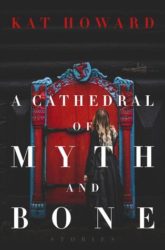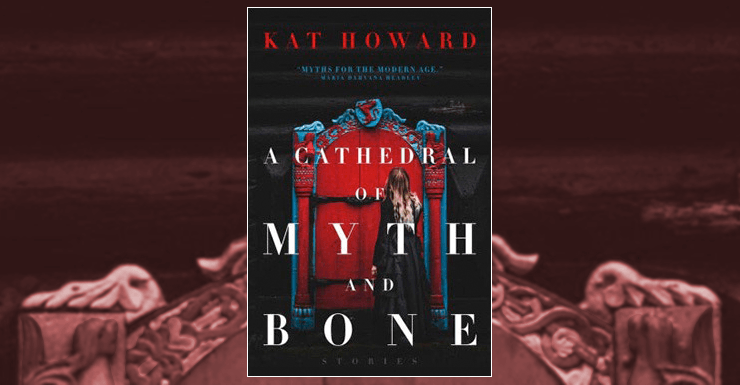I always feel apologetic about collections. And anthologies, for that matter: I’m far less well read with regard to short fiction in the genres of the fantastic than I am with regard to novels and novellas. I know, as always, what I like. How that fits into wider trends… that often puzzles me.
A Cathedral of Myth and Bone is Kat Howard’s first short story collection. It follows her first two novels, Roses and Rot and An Unkindness of Magicians, in being published by Saga Press, and like those two novels, it’s clear that A Cathedral of Myth and Bone is the work of a deft and accomplished writer, deeply influenced by fairy tale and fable, elfland and Arthuriana. As a collection, it’s unified by its interest in transformations and impossible journeys, in the entry of the numinous into the everyday and in connections between women—as sisters, as rivals, as friends, as family. (Though I may be interpreting some of the first-person narrators as women through implicit cues, rather than explicitly-stated evidence.) All of the stories are technically adept. Most of them are downright impressive.
The longest story in the collection, taking up a little over one third of its 360 pages, is the novella “Once, Future,” here published for the first time. “Once, Future” takes as its central concern the Arthurian mythos and the patterns of story: how the Arthurian story has a pattern that can be fitted to many different sets of events throughout history. Set on a modern college campus, it sees a small group of students—guided by an inscrutable and not necessarily well-meaning lecturer—take on the names and roles of Arthurian characters. Yet the enduring truth of Arthurian stories is that, however gilded the golden age, Arthur fails at the end. Arthur dies, or as near as makes no difference.
The main character of “Once, Future” is a modern Morgan, who shares a name with Morgan le Fay—and is assigned Morgan’s role in the story. She finds herself connected across the centuries with a sorceress out of time—the original Morgan—with magic blossoming in her hands. It is up to this new Morgan to find a way to change the story, to turn the ending so that her friend Sabra (in the role of Arthur) survives the end of term—and not in a “once and future” sense.
Buy the Book


A Cathedral of Myth and Bone
“Once, Future” recollects the mood and use of literature of Pamela Dean’s Tam Lin, and Howard’s own Tam Lin-influenced Roses and Rot. It interweaves the mythic with the everyday, until the everyday itself takes on a liminal, numinous quality. Gorgeously written, elegantly characterised, and entirely compelling, it’s an entirely lovely piece of work. (And I do like a queer female Arthur, on those few occasions where I’m presented with one.) “Once, Future” is an excellent novella, and more than justifies the collection on its own.
But there are fifteen more stories in A Cathedral of Myth and Bone besides “Once, Future.” A good number of them are very short: a couple, no more than five or ten pages, among them “Returned,” a vengeful, eerie retelling of Orpheus and Eurydike, in which the Orpheus-figure is a possessive, abusive boyfriend and the Eurydike-figure reclaims her independence in the only way that’s left to her.
My favourite stories from the rest of the collection are two of the longer ones. “Atmospheric” is a word that could describe the vast majority of the stories here, but “Saints Tide,” another story original to the collection, is especially so. This is a piece about family and faith, transformation and feeling, the intrusion of the numinous into the ordinary. “Painted Birds and Shivered Bones” is a story about unexpected connections, about art and transformation and kinds of madness, so to speak—strong social anxiety paired with the madness of turning into a bird—and the nature of curses.
In A Cathedral of Myth and Bone, Kat Howard has given us a strong collection, showcasing her talents and her current literary thematic interests. Deft, elegant, and eloquent, this is the work of a writer whose voice I only expect to grow stronger and more capable over time. Recommended.
A Cathedral of Myth and Bone is available from Saga Press.
Liz Bourke is a cranky queer person who reads books. She holds a Ph.D in Classics from Trinity College, Dublin. Her first book, Sleeping With Monsters, a collection of reviews and criticism, was published in 2017 by Aqueduct Press. It was a finalist for the 2018 Locus Awards and was nominated for a 2018 Hugo Award in Best Related Work. Find her at her blog, where she’s been known to talk about even more books thanks to her Patreon supporters. Or find her at her Twitter. She supports the work of the Irish Refugee Council, the Transgender Equality Network Ireland, and the Abortion Rights Campaign.










